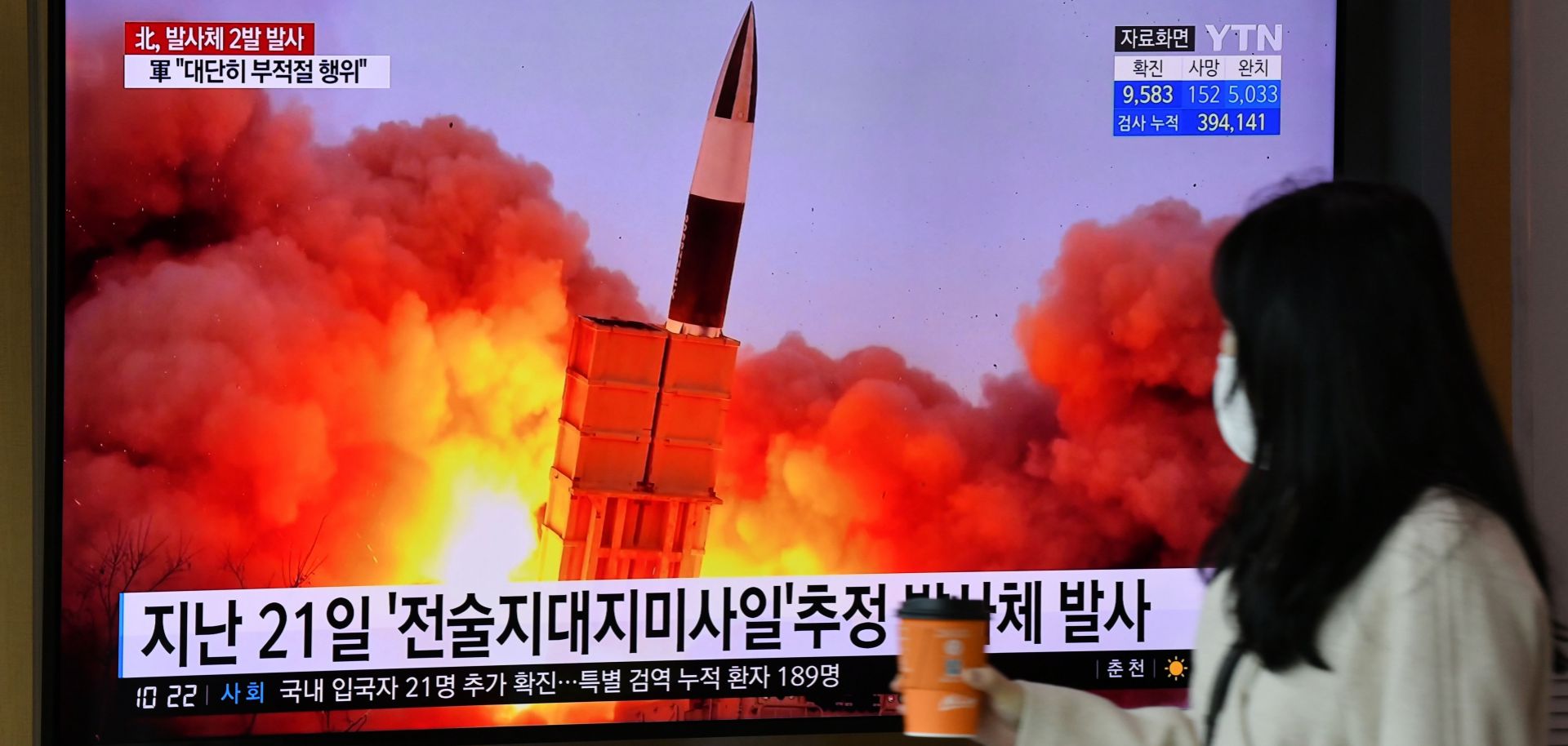Under Kim Jong Un, North Korea has rapidly accelerated its longer-range ballistic missile and nuclear programs. But Pyongyang has also focused on short-range systems as part of an effort to modernize its military capability for contingencies on the Korean Peninsula.
The Threat of North Korea’s Missile Programs
In March, North Korea carried out a cruise missile test, as well as a test of maneuverable short-range ballistic missiles. The two tests came amid the spring training exercises and ended a year-long lapse in missile tests as Pyongyang focused its attention on managing the COVID-19 crisis. Satellite imagery and photos from military parades suggest North Korea may be preparing another test of its submarine-launched ballistic missile, perhaps coinciding with the launch of its new ballistic missile submarine. These tests reflect the two prongs of North Korea’s overall defense strategy: securing second-strike nuclear capability against the United States, and modernizing its missile and rocket systems for operations on the Korean Peninsula.
The United States has long been concerned by North Korea’s intermediate and long-range missile programs, particularly coupled with Pyongyang’s nuclear weapons program. But South Korea and nearby Japan have been equally (if not more) concerned with the shorter-range systems in North Korea’s arsenal, which are designed to strike at U.S. and U.S.-allied military facilities in the region. For Seoul and Tokyo, Pyongyang’s shorter-range ballistic missiles, cruise missiles and large-caliber multiple launch rocket systems (MLRS) have not only proven to be more reliable but are also more likely to be used in regional contingencies that may fall shy of a full war with the United States. The 2010 shelling of South Korea’s Yeonpyeong islands, for example, included North Korean MLRS systems, inflicting damage on military and civilian infrastructure.

An Evolving Defense Posture
As the Cold War neared its end, Kim Il Sung accelerated the development of North Korea’s nuclear program, seeking to ensure a domestic deterrent capability amid weakening support from Russia and China. Under Kim Il Sung, North Korea carried out few ballistic missile tests, and none with a range to strike at U.S. territory. Rather than domestic testing, North Korea relied on transferred technology, joint development with third countries, and avoiding demonstrations of failure. The ambiguity of the effectiveness of these systems was seen as more valuable than proving them, and the fear was that failure may have invited more aggressive action from South Korea or the United States.
The U.S.-North Korea Agreed Framework was intended to dissuade further North Korean nuclear developments, but the death of Kim Il Sung shortly before the agreement was signed in 1994 altered the North Korean trajectory. Upon taking control of North Korea, Kim Jong Il sought to shore up his support from the military and pursued a demonstrable long-range missile, in the guise of a space launch vehicle, as a way to showcase North Korea’s defensive strength, even amid years of famine. However, under Kim Jong Il, North Korea coupled its missile and nuclear development with a series of dialogues, using the programs as much for bargaining chips as for national defense. It wasn’t until after Kim Jong Il’s stroke in 2008 that the North rapidly accelerated its long-range nuclear weapons program, with Kim seeking to hand over a completed capability to his successor.

Kim Jong Un: Nuclear Deterrence Plus Military Modernization
North Korea’s most dramatic and sustained advancements have come under Kim Jong Un, who has emphasized the dual focus on long-range nuclear deterrence and in-theater military modernization. Despite its large military, North Korea cannot compete head-to-head with South Korea or the United States, and much of Pyongyang’s conventional deterrent, particularly its frontline artillery systems, have become outdated. Kim Jong Un has focused on managing North Korea’s weaknesses by completing long-range, nuclear-capable missile systems and ramping up the development of short-range missiles and large-caliber multiple launch rocket systems (MLRS). The strategic systems have focused on road-mobile missiles, and shortening the time from deployment to launch. This is intended to provide at least some potential for a second strike capability, something reinforced by Pyongyang’s focus on a submarine-launched ballistic missile. Together, these systems raise the cost calculus for the United States of any pre-emptive strike against North Korea, as Pyongyang may retain the ability to strike back with a nuclear-armed missile.
The other half of the strategy has focused on short-range missiles, including more advanced anti-ship missiles and missiles with more complex flight paths, in an effort to counter U.S., South Korean and Japanese missile defense systems. The heavy focus in recent years on MLRS systems like the KN25, which seem to blur the line between rockets and missiles, serves as a conventional deterrent, increasing North Korea’s ability to overwhelm in-theater missile defense systems and target allied airfields, military bases and supply centers. North Korea’s frontline artillery has long been a deterrent to military action, but primarily as a saturation attack against the greater Seoul area. The newer systems Pyongyang is developing and deploying are more tactical in nature, increasing range and accuracy. Rather than a desperate volley quickly overwhelmed by U.S. and South Korean forces, the newer systems provide the North with a more intentional counter-strike capability.



